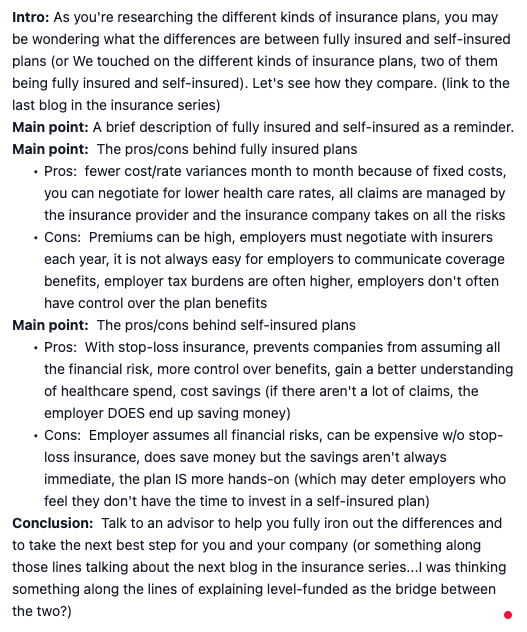I have an idea for a blog post. Where do I start, and how do I write it?
Using a defined structure to write a blog post will make the process easier. Before starting a blog post, follow the suggestions below.
A blog post is any written piece of content posted on the blog section of a website. It:
- Covers a specific topic
- Is educational in nature
- Can be short-form or long-form
- Contains images, videos, or infographics
Blog posts boost your brand awareness, increase your credibility in your field, and drive conversions, revenue, and traffic to your website.
How do I get started?
Make sure you have a blog section on your website, which you can create using your content management system (CMS).
To get started with writing a blog post:
Choose a familiar topic
For instance, if you want to write about the differences between types of health insurance, the topic could be a brief overview of the two major types of health insurance: fully insured and self-funded.
Choose a working title
A working title is a way to help you approach and focus on a topic while writing. The health insurance blog title “Fully Insured and Self-Funded Plans: The Pros and Cons” could start with a working title of “Fully Insured vs. Self-Funded Insurance.”
Create an outline
An outline is a way to organize the blog post, so it will make sense to you (as you are writing it) and to your audience (when they read the published blog post). Also, it helps organize the points you want to cover.
There are many ways to structure an outline. Here is one example:

The outline structure may change as the blog is written.
Write the blog post
Use the outline as a guide to write your blog post. To make a quality post:
- Create an opening paragraph to set up the topic and draw the reader in. This opening paragraph is called the hook, and the setting and summing up of the topic and what it is about is called the thesis statement. The thesis statement includes three supporting points.
- Include three or more body paragraphs to make your case. In these paragraphs, you will support your chosen topic using the supporting points and adding additional research, information, examples, and data to back up your points.
- A conclusion, which sums up the entire blog post and gives people an idea to think about or a takeaway to apply.
Proofread and edit the blog post
Before publishing the blog post, editing and proofreading are crucial. Editing occurs throughout the entire time you’re writing the blog post and involves:
- Structuring the blog post for readability (headers, bullet-pointed lists)
- Revising for clarity (making sure everything would make sense to your audience)
- Adjusting for flow (making sure ideas follow a structure and make sense from one paragraph to the next)
Proofreading usually occurs at the final stage, right before the blog is published. Proofreading involves:
- Checking for misspelled words
- Checking for punctuation omissions or needed additions
- Checking for grammar issues
Edit and proofread the blog post, and then ask someone who is grammar-conscious and editing-conscious to edit and proofread for you.
Once the blog post has been thoroughly edited and proofread, it is ready to publish on your blog platform of choice.